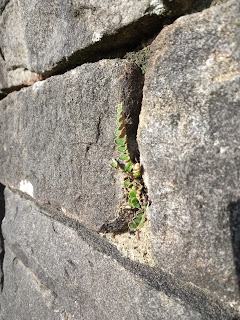Friday 27th May
A joint meeting with the Bradford Botany Group
Leaders: Kay McDowell and Peter Burton
It was a windy but sunny day. We met on the side of the A635 for our visit to the old quarry, known officially as ‘Kaye Stone Pits.’ The A635 Holmfirth Road is often called the Isle of Skye road. The quarry is known as Isle of Skye quarry. It was labelled as ‘disused’ on the 1929 OS map, therefore it has been abandoned for about 100 years. The site is known by local botanists for being a botanically diverse site, but for most of the group it was their first visit.
Some of our group were already finding interesting plants at the quarry entrance, including a flowering St Dabeoc’s heath possibly ‘Atropurpurea’ or a named cultivar ‘Irish Princess’, with striking pink-purplish flowers, a naturalised garden throw out. A wet flush running down towards the road provided a niche for common cottongrass (Eriophorum angustifolium) and bog stitchwort (Stellaria alsine).
We walked through the entrance to the old quarry and spotted some golden-scaled male-fern (Dryopteris affinis ssp. affinis) growing on a cliff ledge, as well as a red-stemmed lady fern (Athyrium filix-femina). Then we encountered our first flowering orchid, a southern marsh-orchid (Dactylorhiza praetermissa). Pale lady’s-mantle (Alchemilla xanthochlora) was next, which is the most common species of native lady’s-mantle in this area.
Our first sedge of the day were several pill sedge (Carex pilulifera). Then we looked at strange looking sedge with mixed congested male and female heads which confused us, but the leaves were green on top but glaucous below. It was later confirmed as glaucous sedge (Carex flacca). We came to the conclusion that the dry winter and early spring was producing odd looking plants. Oval sedge (Carex leporina) was found a little further on, and also after changing forget-me-not (Myosotis discolor) in flower.
The site contains a good number of willow species, one of the first to gain our attention was eared willow (Salix aurita), followed by creeping willow (Salix repens). Then a mystery willow which turned out to be almond willow (Salix triandra). Across towards the cliff/quarry side was a group of willows including white willow (Salix alba), standing out from the grey willow (Salix cinerea) and goat willow (Salix caprea).
Both marsh horsetail (Equisetum palustre), water horsetail (Equisetum fluviatile) were recorded in a shallow pool. Mike reminded me that one of its main identification features of water horsetail is that it has hollow stems and no branches. There was also a nice stand of spike rush (Eleocharis palustris). Common sedge (Carex nigra) was our next sedge, we looked at the stomata seen on the upper surface of the leaf seen through a hand lens.
We found some yellow rattle (Rhinanthus minor) with dotted stems which we at first mistook for greater yellow-rattle (Rhinanthus angustifolius) as we thought we could see protruding stigma and possibly a horizontal lower lip but it was later confirmed as R. minor. It wasn’t greater yellow-rattle as that has larger teeth on the upper lip of the corolla and a pale inflated calyx. It seems there is quite a lot of variety within R. minor.
We had our lunch sheltered from the wind, and spotted a small copper (Lycaena phlaeas). There were more southern marsh-orchids, and a red damselfly was also taking shelter. The next pond contained bottle sedge (Carex rostrata). I was persuaded to wade in and get a specimen to show the rest of the group as I was the only one wearing wellies.
On the bank next to the pool we spotted another orchid species, this time it was common twayblade (Neottia ovata), growing with some typical moorland species including heather (Calluna vulgaris), crowberry (Empetrum nigrum), heath rush (Juncus squarrosus) and mat-grass (Nardus stricta). It was nice to see some small rosette leaves of common centaury (Centaurium erythraea), which was not quite in flower yet.
Finally we saw some colourful flowering broom (Cytisus scoparius), a garden escape amongst another group of willows. Then we made our way back to our cars, feeling satisfied with our botanical finds.
In early July botanist Michael Wilcox visited the site and found some more good records, including confused eyebright (Euphrasia confusa), confirmed Chris Metherell, the BSBI Euphrasia referee. Two others determined by Chris were arctic eyebright (E. arctica) and the hybrid between these two parents; (E. arctica x E. confusa).
Michael also found twelve species of willow, including a purple willow (Salix purpurea ssp. lambertiana) and the hybrid between goat and eared willow (S.caprea x aurita).
Photos kindly taken by Graham Heffernan and Michael Wilcox.
 |
| Alchemilla xanthochlora |
 |
| Daboecia cantabrica |
 |
| Dactylorhiza praetermissa |
 |
| Salix caprea |






